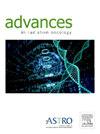Toxicities Associated with Adjuvant Radiation Therapy in Atypical Meningioma
IF 2.2
Q3 ONCOLOGY
引用次数: 0
Abstract
Purpose
While adjuvant radiation therapy (RT) may prolong progression-free survival in resected atypical meningiomas, whether such progression-free survival benefit outweighs potential treatment toxicities remains controversial. Here, we compare the acute and late toxicity outcomes of atypical meningiomas managed with upfront adjuvant RT versus surveillance.
Methods and Materials
In our prior single-institution retrospective study of 230 patients with resected atypical meningiomas between 2000 and 2015, adjuvant RT was associated with a significantly lower risk of progression/recurrence compared with surveillance (hazard ratio, 0.21; P < .01), with 36% of surveillance patients eventually requiring salvage RT. In this study, the acute (≤6 months) and late (>6 months) RT toxicities from the same patient cohort for those who received adjuvant (n = 51) versus salvage RT (n = 64) were compared. Additionally, treatment toxicity at the last follow-up was compared between the adjuvant RT (n = 51) and the surveillance (n = 179) groups. Toxicities were graded per the Common Terminology Criteria for Adverse Events v5.0.
Results
RT in the adjuvant compared with the salvage setting was generally associated with greater RT toxicities both in the acute (90% vs 69%, P < .01) and late (57% vs 33%, P = .01) setting. While there was no significant difference in grade 3 to 4 acute toxicities, late grade 3 to 4 toxicities were present in 14% of the adjuvant group versus 3% of the salvage RT group (P = .04). Radionecrosis was present in 18% of adjuvant RT versus 8% of salvage RT group (P = .11). Between the adjuvant RT and surveillance groups, any treatment-related toxicity at the last follow-up was greater in the adjuvant RT group (31% vs 15%, P < .01), with a trend toward greater grade 3 to 4 toxicities (8% vs 3%, P = .10). There was no difference in the rate of cerebrovascular accident (4% vs 4%, P = .99).
Conclusions
Adjuvant RT may be associated with greater acute and late treatment toxicities, which can significantly impact the quality of life of patients with atypical meningioma. Potential RT toxicity should be carefully weighed against tumor control benefits in deciding the optimal use and timing of RT.
非典型脑膜瘤辅助放射治疗的毒性
目的:虽然辅助放射治疗(RT)可以延长切除的非典型脑膜瘤的无进展生存期,但这种无进展生存期的益处是否超过潜在的治疗毒性仍然存在争议。在这里,我们比较了非典型脑膜瘤的急性和晚期毒性结果,术前辅助放疗与监测。方法和材料在我们之前的单机构回顾性研究中,在2000年至2015年期间对230例切除的非典型脑膜瘤患者进行了研究,与对照组相比,辅助放疗与进展/复发风险显著降低相关(风险比,0.21;P & lt;0.01), 36%的监测患者最终需要补救性放疗。在本研究中,对同一患者队列中接受辅助放疗(n = 51)和补救性放疗(n = 64)的急性(≤6个月)和晚期(>;6个月)的放疗毒性进行了比较。此外,在最后一次随访时比较辅助RT组(n = 51)和监测组(n = 179)的治疗毒性。根据不良事件通用术语标准v5.0对毒性进行分级。结果辅助放疗与救助放疗相比,急性期放疗毒性更大(90% vs 69%, P <;.01)和晚期(57% vs 33%, P = .01)。虽然3至4级急性毒性没有显著差异,但14%的辅助治疗组和3%的补救性放射治疗组存在晚期3至4级毒性(P = 0.04)。辅助放疗组放射性坏死发生率为18%,补救性放疗组为8% (P = 0.11)。在辅助放疗组和监测组之间,最后一次随访时,辅助放疗组的任何治疗相关毒性都更大(31% vs 15%, P <;.01), 3 ~ 4级毒性倾向加重(8% vs 3%, P = .10)。脑血管意外发生率无差异(4% vs 4%, P = 0.99)。结论辅助放疗可能存在较大的急性和晚期治疗毒性,严重影响非典型脑膜瘤患者的生活质量。在决定RT的最佳使用和时机时,应仔细权衡潜在的RT毒性与肿瘤控制益处。
本文章由计算机程序翻译,如有差异,请以英文原文为准。
求助全文
约1分钟内获得全文
求助全文
来源期刊

Advances in Radiation Oncology
Medicine-Radiology, Nuclear Medicine and Imaging
CiteScore
4.60
自引率
4.30%
发文量
208
审稿时长
98 days
期刊介绍:
The purpose of Advances is to provide information for clinicians who use radiation therapy by publishing: Clinical trial reports and reanalyses. Basic science original reports. Manuscripts examining health services research, comparative and cost effectiveness research, and systematic reviews. Case reports documenting unusual problems and solutions. High quality multi and single institutional series, as well as other novel retrospective hypothesis generating series. Timely critical reviews on important topics in radiation oncology, such as side effects. Articles reporting the natural history of disease and patterns of failure, particularly as they relate to treatment volume delineation. Articles on safety and quality in radiation therapy. Essays on clinical experience. Articles on practice transformation in radiation oncology, in particular: Aspects of health policy that may impact the future practice of radiation oncology. How information technology, such as data analytics and systems innovations, will change radiation oncology practice. Articles on imaging as they relate to radiation therapy treatment.
 求助内容:
求助内容: 应助结果提醒方式:
应助结果提醒方式:


